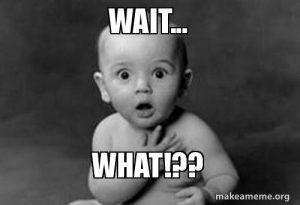Did the city really spend $45,000 on downtown flowers?
Did the city really spend $45,000 on downtown flowers?That was the impression given by a recent post on the city’s blog, which did indeed include the following bullet point in a list of “budgeted strategic plan goals”:
• Hanging basket materials and upkeep: $45,000
However, a typo in that post misidentified this amount as being budgeted for a single fiscal year (2020). In fact, because we were discussing cumulative expenditures from sales tax revenues, and because the sales tax is now in its second year, the figures in that blog post’s list were totals of the line items from two fiscal years.
So, the $45,000 figure you may have seen or heard came from budgeted downtown flowers expenditures for not one year but for both FY 2019 ($25,000) and FY 2020 ($20,000).
Hanging Basket Season /= Fiscal Years
Fiscal year budget amounts aren’t very helpful in understanding the cost of the downtown flowers program, though. That’s because the season for the flower display starts in one fiscal year and ends in the next. (In West Virginia, fiscal years run July 1-June 30, but our flower display is up May-early October, i.e., through Forest Festival.)
That means that each fiscal year’s downtown flowers budget line pays for the end of one year’s season (July-October) and the beginning of the next year’s (May-June).
So, right now, we haven’t finished FY 2020 spending on the flowers program (FY 2020 ends in June). And, on July 1—smack in the middle of the season—we’ll start spending from the FY 2021 budget line item.
Perhaps it would be helpful to look at the cost of this program by season, instead of dividing it between fiscal years.
The full cost of the 2019 downtown flowers season (May-Forest Festival 2019) was $36,541—a cost that was paid out of two different fiscal years, as mentioned.
Our contractor’s proposal for the 2020 downtown flowers season (May-October) is lower than last year’s, at $33,100. That includes $8,100 in supplies and equipment and $25,000 in labor costs. (Again, some of that total will come from the FY 2020 budget, and some will come from the FY 2021 budget, so the FY 2021 budget amount will be much closer to the FY 2019 and 2020 amounts.)
Based on these two years’ experience, then, it looks like we can say that the current downtown flowers program—the one you saw last spring and summer—costs about $30-35,000 a season.
Should We Be Spending This Much Money on Flowers?
That’s a substantial amount of money. When considering any public expenditure, two important questions are whether the amount is fair and whether, even if fair, it is worth doing. Put another way, even if the price for the program is a fair one, reasonable people may disagree on whether the city should be spending money this way at all.
Let’s take the second question first. Why is the city willing to pay this much for downtown flowers? Council has approved expenditures for this program based on its conclusion that it fits with the city’s long-term strategic goals of encouraging tourism and transforming the downtown streetscape to be more inviting for residents, customers of existing businesses, and prospective new businesses.
The flowers are in place during multiple important city events that draw significant numbers of visitors downtown each year, including the Ramps and Rail Festival, Independence Day weekend, the Augusta Heritage Festival, the Mountain State Forest Festival, Elkins Main Street First Friday events, and the weekly Mountain State Street Machines cruise-ins.
Does an impressive flower display encourage return visits by tourists or prospective business owners? Although city officials have received positive feedback from visitors about the flowers, there is no way to be certain how much of an effect they have. However, it seems reasonable to assume that downgrading the attractiveness of our streetscape would not add to the city’s appeal.
Cost Breakdown
Before we can talk about whether we should be spending this much money on this program, we need a clear picture of where each dollar goes. Let’s return to that first question—about whether the cost is a fair one—by taking a closer look at how the money budgeted for downtown flowers is spent.
First, some vital statistics. This program places flowering annuals in 54 locations around downtown, including:
• 36 24-inch hanging baskets
• 14 “hay racks” (e.g., Davis Avenue bridge and the Darden House)
• 4 concrete planters at city hall
As a reminder, the projected costs for the 2020 season (which, again, will be paid partly from the current FY 2020 budget and partly from the upcoming FY 2021 budget) are:
• Supplies and equipment: $8,100
• Labor: $25,000
Supply Costs
To fill the 54 different baskets, hay racks, and planters, our contractor orders about 500 seedlings, or “plugs.” (This year’s varieties are red and purple petunias and silver dichondra.) The plants are a custom order so that they can be grown together for consistency of appearance.
In addition to these 500 plugs, other supply costs include:
• Periodic replacement of basket liners and baskets
• Soil additives and fertilizers
• Counter measures for fungal or pest infestations
Here is a breakdown of the $8,100 in supply costs for the upcoming season:
• 12 replacement basket liners: $300
• 4 replacement baskets: $300
• 500 flower plugs: $6,250
• Soil, additives, fertilizers, and treatments: $1,250
The contractor uses a pickup truck with a 350-gallon tank and pump, all purchased for this work. The proposed 2020 season costs do not include line items for vehicle fuel, maintenance, replacement pump parts, or any other equipment-related expenses.
Labor Costs
Maintaining plantings of this kind in an urban environment is challenging. If you agree that a flower display like the one we had last May-October is worthwhile (and you may not), the fact is that daily watering is required—and not only that, but daily skilled attention and maintenance.
The city has experimented in the past with procuring such services by relying on volunteers and/or city employees. These approaches encountered obstacles around consistency, equipment needs, overtime expenses, and lack of horticultural expertise.
So, in 2019, to protect its significant investment in flowers for the downtown display, the city contracted with a local business to plant the flowers, hang the baskets, and provide daily watering, maintenance, and care.
Here is what that work looks like:
• Planning, ordering, and coordinating with grower each fall
• Soil preparation, planting, and hanging: 4-5 days in May
• Daily rounds of 54 watering and inspection stops each morning
• Evening rounds for pesticide/fungicide application as needed
The contractor uses two people to perform the watering, a driver to position the truck under each basket and another person to operate the pump and hose. When only one person is available, the process takes longer.
This watering costs the city less than $17.25 an hour, based on the following:
• 5 minutes per stop X 54 stops = 4.5 hours a day
• 161 days each season
• 4.5 hours X 161 = 724.5 hours
• $25,000/724.5 = $34.50/hour (for two people)
• $34.50/2 = $17.25 per person
By way of comparison, a city employee making $10.39/hour costs the city nearly $20 an hour, when benefits and city share of withholding taxes are included. And remember, because the daily watering is not the only service being provided (other services include the fall planning, initial planting and basket installation, and pesticide and fungicide treatments), the city’s hourly labor cost for the downtown flowers program is even lower than $17.25 an hour.
In other words, you might disagree that the city should be spending money on downtown flowers. However, if you do agree that a flower display of this kind is important for the aesthetic and visual appeal it provides the town of Elkins, it is not obvious how it could be accomplished at a significantly lower cost than that of the current program.

City Council Adopts New Strategic Plan for 2024-2029
Elkins W. Va., August 20, 2024: The Elkins Common Council has officially adopted its 2024-2029 Strategic Plan, a comprehensive roadmap that sets the city’s priorities for the next five years. This plan is designed to enhance the quality of life for residents, […]
Read More
